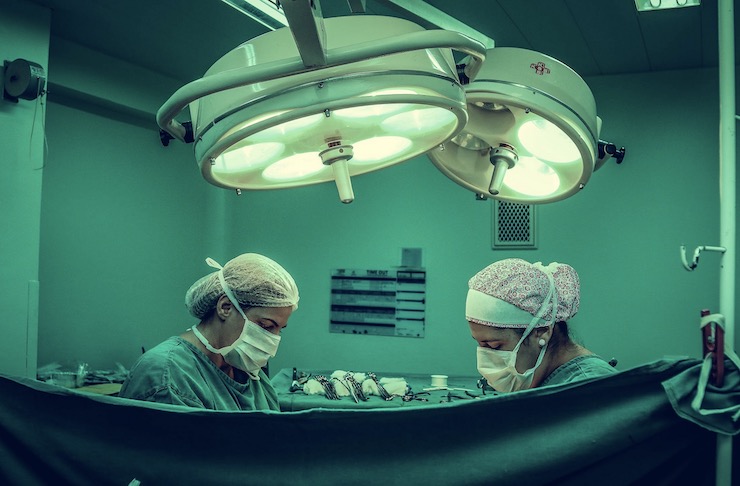When Hospitals Need an Organ Transplant, Should They Call For a Drone?

Drones offer many technological and logistical advantages over fixed-wing aircraft and helicopters, in a variety of settings. but when it comes to transporting freshly harvested human organs, the most important of these advantages are speed and travel time.
Hearts and lungs can only survive intact for a few short hours after being extracted from their donors. And a surprisingly high number of these donated organs – at least a quarter, in the case of kidneys, the organ most commonly harvested – are still deemed unfit for transplant because of the damaged condition in which they arrive. The problem isn’t the organ – it’s their means of transport.
Road vehicles often encounter heavy traffic (or crash) and many fail to arrive on time. Air cargo flights are unexpectedly delayed or rescheduled – or simply canceled. Helicopters are one alternative – but only if the trip is short. Choppers lack sufficient fuel and speed to travel the hundreds of miles that may be required to reach a waiting organ recipient.
Hospitals have known for some time that drones might be useful for organ transport but getting the approval of the Federal Aviation Administration (FAA) hasn’t been easy. The first serious proof-of-concept tests got underway about four years ago – and the results were promising. For example, in March 2018, a group of surgeons at the University of Maryland led by Dr. Joseph Scalea conducted more than a dozen experiments with a drone carrying a harvested kidney at various distances, including 2.4 kilometers, the distance estimated between inner-city hospitals. The bean-shaped organ survived each of the aircraft ’s 14 journeys intact.
A year later, Scalea received permission to test the concept during a live kidney transplant, which Scales himself supervised. The project included collaboration with the University of Maryland (UMD) Medical System, UMD’s Unmanned Aircraft Systems Test Site, and the nonprofit Living Legacy Foundation. After garnering headlines worldwide, Scalea & Co. then traveled to Nevada to organize the first successful drone transport of another harvested organ – eye cornea – this one conducted over a distance of more than 10 miles, the longest so far.
Thanks to these widely heralded successes, support from medical professionals for the use of organ donor drones appears to be growing. A survey among surgeons conducted in 2019 found that the vast majority were dissatisfied with conventional transport methods due to the relatively high rate of damaged and unusable donor organs that arrived. Many admitted to feeling “nervous” about turning to drones but the vast majority described themselves as “eager” to see the results of additional tests.
As with most current aerial delivery services – most of them for commercial items or non-perishable medical supplies – questions do remain about the viability of smaller propeller-driven drones – given their limited battery power and relatively short flight duration – to support long-distance organ deliveries. One reason? Perishable organs would need to be packed in thick ice to keep them cool during transit, adding considerable weight to the payload.
In the future, to ensure that drone organ deliveries are truly viable, larger fixed-wing drones with heavier batteries and a higher cargo carrying capacity would likely be needed, experts believe.
Experiments with larger aircraft are already underway. Last month, the Texas Organ Sharing Alliance (TOSA), in partnership with Texas Tech and other nonprofits, used a standard fixed-wing Cessna to deliver a small cargo of donated organs to cities hundreds of miles apart. The plane had a pilot in the cockpit – for security – but it flew autonomously, just like a modern drone craft.
“It looks like a plane. It is a plane,” TOSA CEO Joe Nespral said in an interview with a local San Antonio TV station. “But it actually has the technology and the ability to fly without a pilot [just like a drone].”
Nespral said his nonprofit is seeking FAA approval for a drone “corridor” that would allow hospitals to fly autonomous cargo planes nationwide without restriction. Other organizations are petitioning the FAA for similar approval to deliver non-medical supplies.
FAA approval may be coming fairly soon. The agency has been studying the issue of drone corridors as part of an ongoing review of its current regulations governing autonomous drone flights. Last October, the FAA gave New York the go-ahead to establish a drone corridor in a 50-mile radius surrounding the NUAIR drone test site – one of just seven FAA-certified drone “sandboxes” nationwide.
It’s only a step – but a significant one, experts say. Given the urgency that surrounds the skyrocketing demand for organ transplants, the FAA might grant special waivers to hospitals and selected drone companies to facilitate organ donor flights with fewer restrictions. At speeds of up to 200 mph, specially-equipped cargo drones – like the fixed-wing Cessna – could travel several hundreds of miles across several states, if need be, to complete a long-distance delivery with the harvested organ still intact. It’s worth the risk to save even one more life, groups like TOSA say.
|